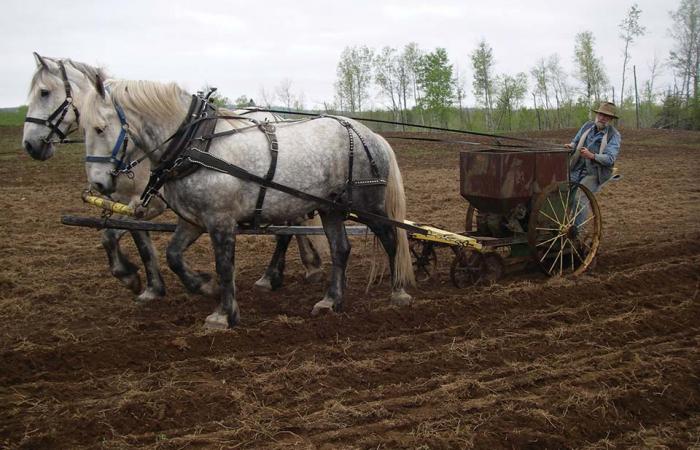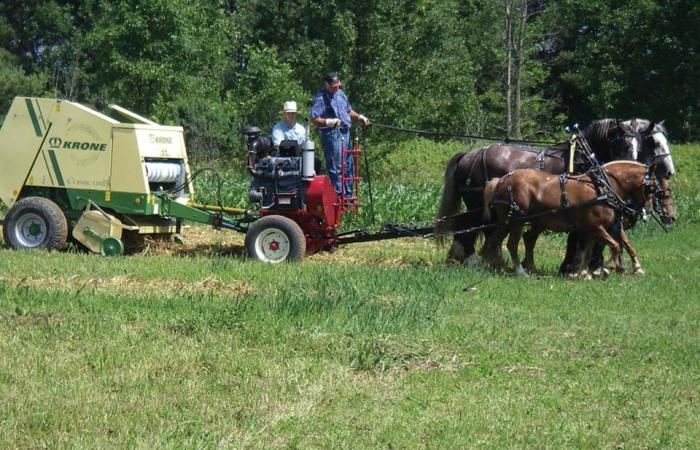Larry Bockus believes that it’s always better to keep one foot in the past whenever you move forward into the future.
In an era when mega farms use modern machinery that can turn, seed, irrigate, fertilize and harvest a 1000-acre field faster than you can say, “My cereal is made from Canadian wheat,” Larry took the more relaxed and days-gone-by route to farming: a team of percheron horses and a plow.
Normally, the only way to see a field being prepared or harvested like in the good ol’ days is to visit a Mennonite or Hutterite farm. But right here in Thunder Bay, in Marks Township, Larry Bockus has plowed his fields with Smoke and Cindy, Bud and Timber, and several other teams who have provided Larry, his wife, Diana, and their children, with a harvest that has fed them throughout the year.
It all began in 1981 when Larry used three teams of two horses to break new ground at their homestead. Once the land was ready for planting, the plow was exchanged for other implements that Larry created using used pieces of machinery from yesteryears. Odds and ends were often bartered for – an exchange of services or goods for a rake or two – but more often than not a retired farmer gave Larry his old machinery saying, “You’re free to borrow it, just don’t bring it back.”
To bring in enough hay to feed the horses for the winter, Larry built a hay mower, a rake, and a round bale baler. To the inexperienced city dweller this may not seem all that remarkable but to a farmer it is worthy of a head nod or two. Horse drawn round balers were non-existent until the late 90’s as it required a motor to turn the hay into a round bale. Larry overcame this obstacle in the mid 90’s by building a motorized forecart on an axel with four wheels which was pulled by the horses while a motor operated the baler. It saved days of pitching dried grass hay onto a cart and moving it into a barn for the winter.
To maintain the 1 1/2 and 2-acre gardens, everything from a potato planter, hilling disc, and potato digger, to a cultivator for weeding were built in Larry’s workshop. Any tool or implement that could make the farming experience a little easier, was imagined, then put together using ingenuity and a little bit of welding, hammering, cutting and piecing together.
This homesteading experience wasn’t limited to just the 22-acre hay fields and gardens. Larry used his horse teams to pull trees from a 190-acre wood lot that provided them with timber for building their home and barns, as well as firewood for the cold winter. After the trees were cut down and allowed to dry during the spring, summer, and fall, Larry waited until the winter snow was deep enough to provide an ice layer for smooth dragging. Using a packer made from six transport truck tires running through an axle, Larry and his horse team flattened the snow so it was easier to skid the trees out once the surface iced up.
Larry can’t honestly say why he’s stuck to using horses rather than machinery on his farm. His grandfather stopped using horses when tractors came into existence in the 1930’s, so it wasn’t something that had been handed down to him.
“When I had the option of using a tractor or horses, I chose the horses because I wasn’t satisfied with a tractor. When you work with horses you create a connection. You communicate through the lines (long reins from horse to driver) and it’s almost like a dance.”
This “dance” developed over time – so much so that Larry’s horses didn’t need his cue to turn in a field and intuitively knew how to come within inches of a fence and maintain an even cut without leaving a trace of grass standing.
One day, while Larry was out in a field cutting hay, a friend stopped by to watch the team in action. The friend decided to give it a go and Larry stood back and observed. After a couple of times around, Larry asked his friend how it went. The friend replied, “Well, once I quit telling the team what to do, they were fine.” Larry laughed. He was proud of his team.
And justifiably so. Up until 2010, the Slate River Plowing Match used to include teams of horses and tractors in the competition to determine who had the best quality plowing. For two years, Larry beat all seven teams of horses as well as the tractors. Now, sadly, there are no longer any horses competing in the event. The horses have retired and passed on or are spending their well-earned rest in a pasture of green grass and purple clover.
But for a time, long after most farmers traded their teams of eight legs for four wheels, Larry sat in his cart, whistling to the beat of his horses’ feet as they cultivated the fields. Whether it was because of necessity or because of the feeling of self satisfaction that Larry got, it’s hard to say. But Larry and his horses knew something many of us will never come to understand: the simple and pure pleasure of keeping one foot in the past while plowing a way into the future.
Editor’s note: Now into their 70’s, Larry and Diana have “retired”. In 2014 they sold their farm and moved onto a hobby farm. They still have their livestock and their gardens – although somewhat smaller, but the workload has decreased allowing for more time to spend with the kids and grandkids. It’s been a bit of an adjustment, but life continues to be wonderful and good.







